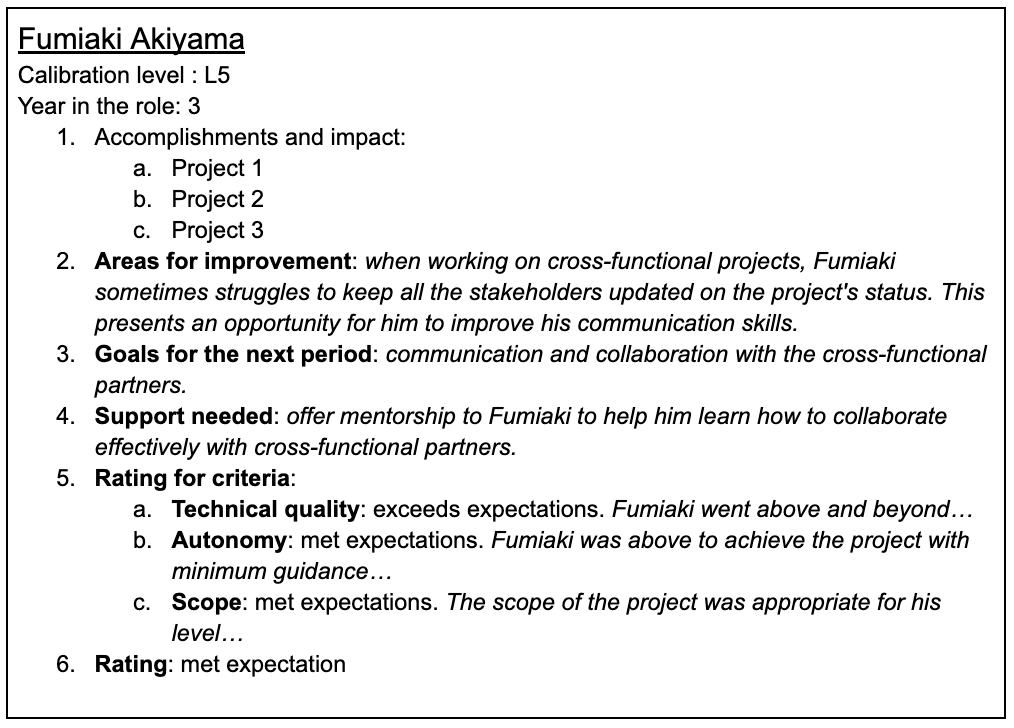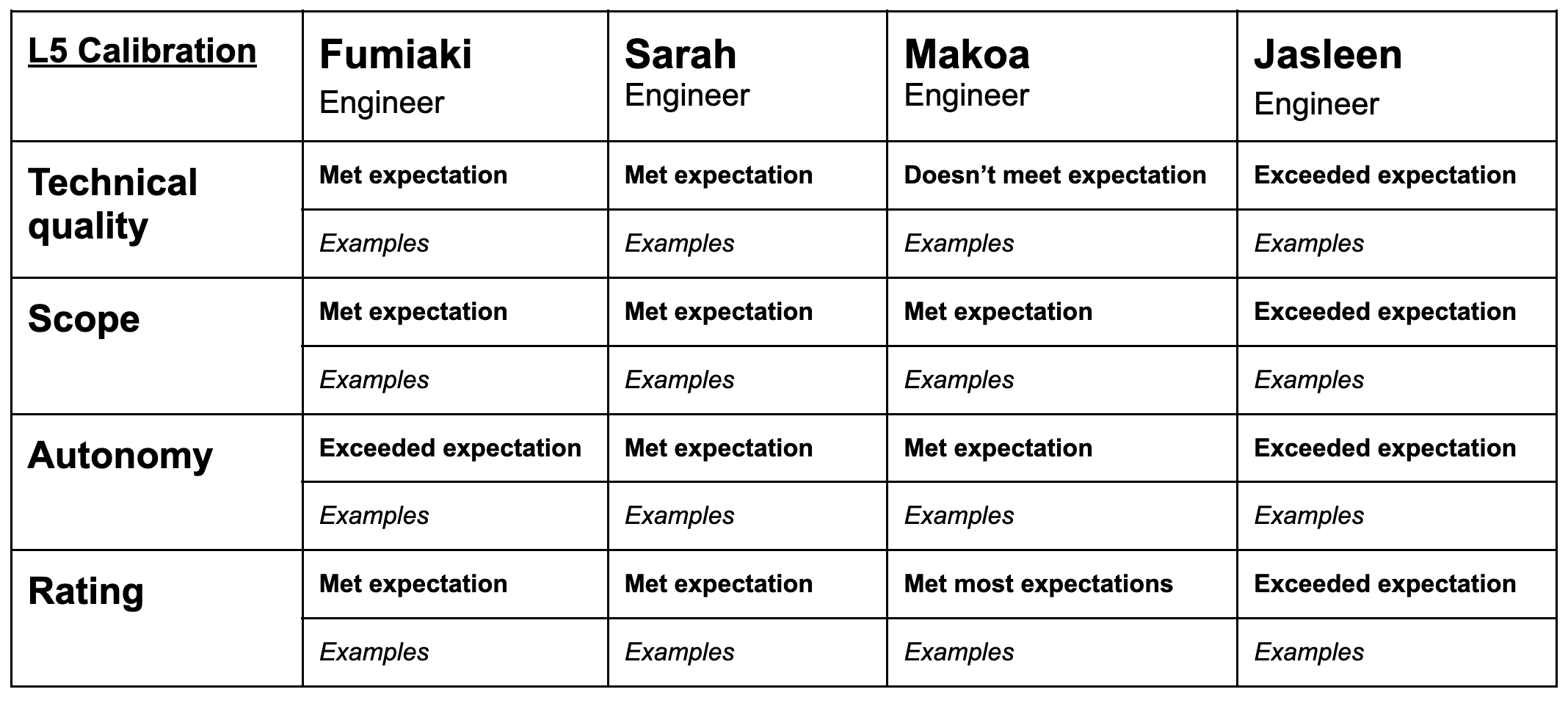You have 1 article left to read this month before you need to register a free LeadDev.com account.
9 minutes
Performance review cycles can be a time of high stress and anxiety for both managers and their reports. Finding methods to streamline the process is therefore invaluable.
The performance review cycle is often a very demanding period for engineering managers, involving reviews, calibrations, promotions, and more. It is also a critical time for our reports as it’s often when we decide to submit promotions or place employees under performance management.
Creating a structured performance review process with streamlined calibration conversations is imperative. But, once these conversations are closed, we also need to follow through on them and continue supporting our team. Along the way, managers should consistently reflect on developing their own leadership skills.
Feedback should be consistent throughout the year
Performance reviews should not be the only time team members receive feedback. Regular, ongoing feedback is vital for continuous development. This helps employees understand their strengths and areas for improvement in real time, reducing stress and any elements of surprise during annual reviews.
Managers must create a culture of open communication where feedback is part of the daily routine. Part of this can include leveraging Slack or Teams channels for real-time feedback, all-hands meetings to highlight engineer development, and review sessions after specific projects are completed. Above all, regular 1:1s are the perfect setup for managers to deliver feedback, allowing for a more dynamic adjustment of goals and expectations.
When feedback is frequent, it becomes a tool for growth rather than a source of anxiety. Moreover, it encourages a culture of trust and openness where employees feel supported and valued. Remember to record everything discussed via a shared doc so it’s easier to remember what was spoken about and when.
This proactive approach to feedback can lead to higher job satisfaction and productivity.
More like this
How to handle career conversations
Career conversations are a critical component of the review cycle and should be conducted with the utmost care. This conversation requires a personal and direct approach to truly understand the employee’s career aspirations, challenges, and development needs. Hold these discussions regularly with your team, outside of the review cycle as well.
Tips for effective career conversations include:
- Prepare in advance: review the employee’s achievements and career aspirations before the meeting. Having a clear understanding of their accomplishments and goals will make the conversation more focused and productive.
- Create a comfortable environment: ensure a private, relaxed setting for the discussion. This helps to put the employee at ease and encourages open and honest dialogue.
- Listen actively: pay close attention to the employee’s input and respond thoughtfully. Show empathy and understanding, and be prepared to provide constructive feedback and guidance.
A meaningful career conversation can significantly impact an employee’s motivation and engagement. It provides an opportunity to align the employee’s career goals with the organization’s objectives, fostering a sense of purpose and direction.
A format for writing reviews
Writing a good review is essential to accurately represent the work that your report has completed across the year. Before even sitting down to document your thoughts, ask your reports to write self-reviews that capture their accomplishments, areas in which they’d like to improve, and their goals for the next period. Additionally, collect peer feedback to gain further insights into their performance.
Defining a format for writing reviews helps structure them, making sure important information is presented and consistency is maintained across the org. Below is a suggested format for written reviews and an example:
- Summary of achievements: highlight key accomplishments since the last review. This section should be specific, focusing on quantifiable results and the impact of the employee’s contributions.
- Areas for improvement: identify specific areas where growth is needed. Use constructive language to frame these areas as opportunities for development rather than shortcomings.
- Goals for the next period: set achievable, measurable objectives. These goals should align with both individual career aspirations and organizational objectives, ensuring mutual benefit.
- Support needed: outline any resources or support required to meet these goals. This might include training, mentorship, or access to certain tools and resources.
- A rating for each criterion of the career ladder: No company will have the same career framework or review process. If your org uses a grading model, make sure you’re employing the company career framework to assess the engineer’s performance against each criterion for their level. For example, if your career framework evaluates criteria such as scope, technical quality, and autonomy, each of these should be assessed to determine whether the engineer is meeting, exceeding, or not meeting the expectations. Providing a brief justification for each rating helps to bring context and clarity to the evaluation.
- The rating: the final, overall rating you assign to the engineer, along with a brief justification.

Fig.1 Written review for one report.
This format not only simplifies the calibration process but also ensures that all aspects of performance are considered. It provides a balanced view of the employee’s contributions and potential areas for growth, facilitating a fair and productive discussion.
A process to calibrate engineers across different teams
Calibration is a process where managers across different teams review engineers at the same level to ensure consistency and fairness in performance evaluations. It culminates in a meeting often conducted within the organization or sub-organization.
The overall goal of calibration is to apply the same standards across departments and is an essential step for reducing bias and enhancing fairness.
Before the calibration meeting
To facilitate the calibration process, consolidate the individual review notes of the engineers being evaluated into a single table. Several managers across the engineering org will have access to this document, inputting feedback on their own reports. 
Fig.2 Calibration of level five engineers.
Calibration meetings involve different attendees based on the employee levels being reviewed. For engineers up to the senior level, managers and staff engineers typically attend. When the focus shifts to staff+ employees and above, senior managers and directors usually join the meeting. HR can also sometimes be invited; this isn’t mandatory but their presence can be very beneficial. Having an HR representative in the room depends on the organization’s policies and the specific context of the meeting.
The calibration meeting
The next step is to hold a calibration meeting to discuss ratings and align evaluations for every engineer. This meeting is an opportunity to ask questions and challenge ratings, requiring managers to justify their reviews with concrete examples. Since these meetings can be lengthy and involve difficult conversations, it’s recommended to hold one calibration meeting per level.
During the calibration meeting, managers review each engineer’s accomplishments, discuss the proposed rating, and seek consensus. Each engineer’s performance is compared against their peers to ensure fairness and consistency.
Managers should come to this meeting well-prepared, with a clear understanding of their reports’ accomplishments. They should be able to provide concrete examples that justify the ratings they assigned.
Use the company’s career ladder benchmarks as a reference point during the discussion as it defines role expectations at any given level.
For example, let’s consider that the criterion “technical quality” for a level 5 software engineer is defined as follows in your company’s career ladder documentation:
Fig 3. Sample of career ladder.
Now, let’s consider these notes for the calibration meeting.
Fig 4. Sample of calibration notes
Having the career ladder allows you to refer to established expectations and guide the conversation with relevant questions to demonstrate that these expectations have been met. Using Fumiaki’s accomplishments (Fig. 4.) as an example, here are some ways you could ask further questions to cross-reference his successes with the core aspects of the “technical quality” criterion:
- Technical skills: ask probing questions to unearth the complexity of the new feature he implemented.
- Quality: scrutinize what made Fumiaki’s work high-quality code.
- Impact: probe into the new design Fumiaki spearheaded. Ask for elaboration on the “robust and scalable” architecture.
- People leadership: ask for elaboration on which teams Fumiaki has collaborated with and influenced.
As the discussion progresses, always refer back to the expectations for each calibration level to certify alignment with standards. Adjust ratings if inconsistencies arise.
At the end of this process, each engineer’s rating will reflect their performance, considering their peers and the career ladder.
The performance conversation
Managers will then meet with their reports to discuss performance, achievements, challenges, and areas for development. During this conversation, the manager shares the report’s final rating after the calibration meeting and provides feedback. This can sometimes be difficult, especially when the engineer’s performance does not meet expectations.
Managers must be well-prepared to justify the rating clearly while creating an environment where the engineer feels comfortable asking questions.
To make the process more efficient, share the feedback and peer feedback documents in advance. This allows the engineer to review and process the information beforehand, leading to a more meaningful discussion. However, the rating should only be shared during the meeting.
Continuous support after the review cycle
The performance conversation is just the beginning. Managers play a crucial role in following through on identified areas of growth, coaching, and mentoring their team members. Steps to ensure continuous support include:
- Regular check-ins: schedule frequent 1:1 meetings to discuss progress and challenges. These check-ins should be informal and focused on providing support and guidance rather than evaluating performance.
- Action plans: develop detailed action plans based on the review outcomes. These plans should outline specific steps the employee can take to achieve their goals, along with timelines and milestones.
- Resources and training: provide the necessary resources and training to support development goals. This might include access to online courses, workshops, mentorship programs, or coaching.
Ongoing support helps employees stay on track with their development plans and fosters a culture of continuous improvement. It shows that the organization is committed to their growth and development, which can enhance their loyalty and engagement.
A self-retrospective
Leaders should be more intentional and reflective on how they can improve their leadership skills. Self-retrospection is a powerful tool for personal growth. Leaders should regularly ask themselves:
- What went well during the review cycle?
- What challenges did I face, and how can I address them?
- How can I better support my team moving forward?
By reflecting on their experiences and seeking feedback from peers and team members, leaders can identify areas for improvement and develop strategies to enhance their effectiveness. This practice of self-reflection helps leaders to continuously improve and adapt their leadership style to meet the evolving needs of their team.
Final thoughts
The performance review cycle demands intentional leadership and a structured approach. By providing consistent feedback, implementing a standardized review format, conducting personal career conversations, offering continuous support, and engaging in self-reflection, engineering managers can streamline the review process and foster a culture of growth and development.
These strategies not only improve the efficiency of performance reviews but also contribute to a more engaged and motivated engineering team. Through thoughtful and deliberate actions, managers can help their teams achieve their full potential and drive organizational success.




